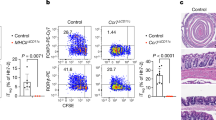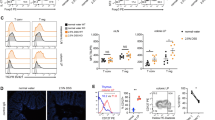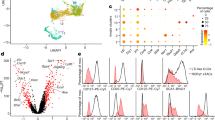Abstract
Interleukin (IL)-17-producing CD4+ T lymphocytes (TH17 cells) constitute a subset of T-helper cells involved in host defence and several immune disorders1,2. An intriguing feature of TH17 cells is their selective and constitutive presence in the intestinal lamina propria3. Here we show that adenosine 5′-triphosphate (ATP) that can be derived from commensal bacteria activates a unique subset of lamina propria cells, CD70highCD11clow cells, leading to the differentiation of TH17 cells. Germ-free mice exhibit much lower concentrations of luminal ATP, accompanied by fewer lamina propria TH17 cells, compared to specific-pathogen-free mice. Systemic or rectal administration of ATP into these germ-free mice results in a marked increase in the number of lamina propria TH17 cells. A CD70highCD11clow subset of the lamina propria cells expresses TH17-prone molecules, such as IL-6, IL-23p19 and transforming-growth-factor-β-activating integrin-αV and -β8, in response to ATP stimulation, and preferentially induces TH17 differentiation of co-cultured naive CD4+ T cells. The critical role of ATP is further underscored by the observation that administration of ATP exacerbates a T-cell-mediated colitis model with enhanced TH17 differentiation. These observations highlight the importance of commensal bacteria and ATP for TH17 differentiation in health and disease, and offer an explanation of why TH17 cells specifically present in the intestinal lamina propria.
This is a preview of subscription content, access via your institution
Access options
Subscribe to this journal
Receive 51 print issues and online access
$199.00 per year
only $3.90 per issue
Buy this article
- Purchase on Springer Link
- Instant access to full article PDF
Prices may be subject to local taxes which are calculated during checkout




Similar content being viewed by others
References
Weaver, C. T., Hatton, R. D., Mangan, P. R. & Harrington, L. E. IL-17 family cytokines and the expanding diversity of effector T cell lineages. Annu. Rev. Immunol. 25, 821–852 (2007)
Bettelli, E., Oukka, M. & Kuchroo, V. K. TH-17 cells in the circle of immunity and autoimmunity. Nature Immunol. 8, 345–350 (2007)
Ivanov, I. I. et al. The orphan nuclear receptor RORγt directs the differentiation program of proinflammatory IL-17+ T helper cells. Cell 126, 1121–1133 (2006)
Liang, S. C. et al. Interleukin (IL)-22 and IL-17 are coexpressed by Th17 cells and cooperatively enhance expression of antimicrobial peptides. J. Exp. Med. 203, 2271–2279 (2006)
Nurieva, R. et al. Essential autocrine regulation by IL-21 in the generation of inflammatory T cells. Nature 448, 480–483 (2007)
Korn, T. et al. IL-21 initiates an alternative pathway to induce proinflammatory TH17 cells. Nature 448, 484–487 (2007)
Zhou, L. et al. IL-6 programs TH-17 cell differentiation by promoting sequential engagement of the IL-21 and IL-23 pathways. Nature Immunol. 8, 967–974 (2007)
Cho, J. H. & Weaver, C. T. The genetics of inflammatory bowel disease. Gastroenterology 133, 1327–1339 (2007)
Veldhoen, M., Hocking, R. J., Atkins, C. J., Locksley, R. M. & Stockinger, B. TGFβ in the context of an inflammatory cytokine milieu supports de novo differentiation of IL-17-producing T cells. Immunity 24, 179–189 (2006)
Mangan, P. R. et al. Transforming growth factor-β induces development of the TH17 lineage. Nature 441, 231–234 (2006)
Bettelli, E. et al. Reciprocal developmental pathways for the generation of pathogenic effector TH17 and regulatory T cells. Nature 441, 235–238 (2006)
Cua, D. J. & Kastelein, R. A. TGF-β, a ‘double agent’ in the immune pathology war. Nature Immunol. 7, 557–559 (2006)
Chang, S. Y. et al. Colonic patches direct the cross-talk between systemic compartments and large intestine independently of innate immunity. J. Immunol. 180, 1609–1618 (2008)
Fagarasan, S. & Honjo, T. Intestinal IgA synthesis: regulation of front-line body defences. Nature Rev. Immunol. 3, 63–72 (2003)
North, R. A. Molecular physiology of P2X receptors. Physiol. Rev. 82, 1013–1067 (2002)
Schnurr, M. et al. Extracellular nucleotide signaling by P2 receptors inhibits IL-12 and enhances IL-23 expression in human dendritic cells: a novel role for the cAMP pathway. Blood 105, 1582–1589 (2005)
Khakh, B. S. & North, R. A. P2X receptors as cell-surface ATP sensors in health and disease. Nature 442, 527–532 (2006)
Idzko, M. et al. Extracellular ATP triggers and maintains asthmatic airway inflammation by activating dendritic cells. Nature Med. 13, 913–919 (2007)
Ivanova, E. P., Alexeeva, Y. V., Pham, D. K., Wright, J. P. & Nicolau, D. V. ATP level variations in heterotrophic bacteria during attachment on hydrophilic and hydrophobic surfaces. Int. Microbiol. 9, 37–46 (2006)
Rescigno, M. et al. Dendritic cells express tight junction proteins and penetrate gut epithelial monolayers to sample bacteria. Nature Immunol. 2, 361–367 (2001)
Niess, J. H. et al. CX3CR1-mediated dendritic cell access to the intestinal lumen and bacterial clearance. Science 307, 254–258 (2005)
Travis, M. A. et al. Loss of integrin alpha(v)beta8 on dendritic cells causes autoimmunity and colitis in mice. Nature 449, 361–365 (2007)
Takeda, K. et al. Stat3 activation is responsible for IL-6-dependent T cell proliferation through preventing apoptosis: generation and characterization of T cell-specific Stat3-deficient mice. J. Immunol. 161, 4652–4660 (1998)
Iwasaki, A. Mucosal dendritic cells. Annu. Rev. Immunol. 25, 381–418 (2007)
Coombes, J. L. et al. A functionally specialized population of mucosal CD103+ DCs induces Foxp3+ regulatory T cells via a TGF-β and retinoic acid-dependent mechanism. J. Exp. Med. 204, 1757–1764 (2007)
Denning, T. L., Wang, Y. C., Patel, S. R., Williams, I. R. & Pulendran, B. Lamina propria macrophages and dendritic cells differentially induce regulatory and interleukin 17-producing T cell responses. Nature Immunol. 8, 1086–1094 (2007)
Hendriks, J. et al. CD27 is required for generation and long-term maintenance of T cell immunity. Nature Immunol. 1, 433–440 (2000)
Zaba, L. C. et al. Amelioration of epidermal hyperplasia by TNF inhibition is associated with reduced Th17 responses. J. Exp. Med. 204, 3183–3194 (2007)
Leach, M. W., Bean, A. G., Mauze, S., Coffman, R. L. & Powrie, F. Inflammatory bowel disease in C.B-17 scid mice reconstituted with the CD45RBhigh subset of CD4+ T cells. Am. J. Pathol. 148, 1503–1515 (1996)
Mazmanian, S. K., Round, J. L. & Kasper, D. L. A microbial symbiosis factor prevents intestinal inflammatory disease. Nature 453, 620–625 (2008)
Yamamoto, M. et al. Role of adaptor TRIF in the MyD88-independent Toll-like receptor signaling pathway. Science 301, 640–643 (2003)
Mizoguchi, E. et al. Colonic epithelial functional phenotype varies with type and phase of experimental colitis. Gastroenterology 125, 148–161 (2003)
Acknowledgements
We thank A. Iwasaki and N. Tsuji for discussion, M. H. Jang, H. Ohno, H. Yamane, M. Yoshida and H. Shiomi for technical advice and reagents, and J. Borst for CD27-deficient mice. This work was supported by Grants-in-Aid from the Ministry of Education, Culture, Sports, Science and Technology, the Ministry of Health, Labour and Welfare, the Osaka Foundation for the Promotion of Clinical Immunology, the Ichiro Kanehara Foundation, Sumitomo Foundation, Senri Life Science Foundation and the Naito Foundation.
Author Contributions K.H. conceived the research, planned experiments and analyses and wrote the paper; K.A. and J.N. largely conducted experiments; T.S. performed some of the experiments; Y.U., M.Y., M.O., H.Y., N.I. and R.E. provided key materials; and K.T. oversaw the whole project.
Author information
Authors and Affiliations
Corresponding authors
Supplementary information
Supplementary Information
The file contains Supplementary Figures 1-12 with Legends. (PDF 4600 kb)
Rights and permissions
About this article
Cite this article
Atarashi, K., Nishimura, J., Shima, T. et al. ATP drives lamina propria TH17 cell differentiation. Nature 455, 808–812 (2008). https://doi.org/10.1038/nature07240
Received:
Accepted:
Published:
Issue Date:
DOI: https://doi.org/10.1038/nature07240
This article is cited by
-
The P2X7 receptor in mucosal adaptive immunity
Purinergic Signalling (2024)
-
The role of purinergic signaling in acupuncture-mediated relief of neuropathic and inflammatory pain
Purinergic Signalling (2024)
-
MHCII expression on gut macrophages supports T cell homeostasis and is regulated by microbiota and ontogeny
Scientific Reports (2023)
-
Epithelial IFNγ signalling and compartmentalized antigen presentation orchestrate gut immunity
Nature (2023)
-
Gut–liver axis: barriers and functional circuits
Nature Reviews Gastroenterology & Hepatology (2023)
Comments
By submitting a comment you agree to abide by our Terms and Community Guidelines. If you find something abusive or that does not comply with our terms or guidelines please flag it as inappropriate.



